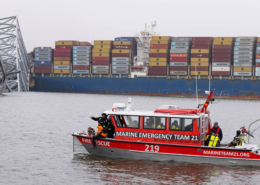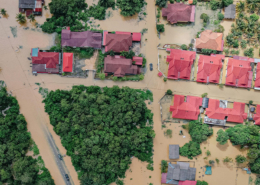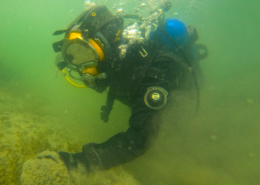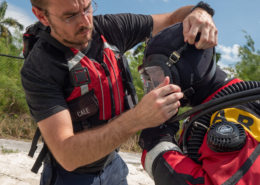Recreational Dive Equipment is NOT Suitable for Public Safety Diving Missions
By: Wayne Hall
We’ve all seen it, the all-volunteer Public Safety Diving Team that shows up to a scene in wetsuits, half masks, and other recreational gear. Some of this gear is personal, some is team property. The team’s divers just want to serve their community and get the mission done – some may not know they are at risk; some have accepted it. On the surface, this sounds fine, but dig into it and there are many problems.
Very little of this gear is suitable for Public Safety Diving missions. First, recreational dive equipment is designed for leisure use, not mucking around in a farm pond with phosphate and other agricultural chemicals that run into the pond. Neoprene wetsuits don’t provide the essential protection against those chemicals nor the fuel and other automotive fluids that are seeping out while these safety divers are conducting a victim search and recovery. That half-mask leaves the cheeks and head exposed also. Those recreational 2nd stages increase the chance of ingesting chemicals directly into the lungs or stomach as the diver fatigues. Are those ropes you got from the hardware store safety and weight rated? Are your metal connectors marine grade and safety rated?
Finally, there is the litigious side of things. If there is a Line of Duty investigation, will the department’s or agency’s worker’s compensation insurance cover that diver if they are injured using this type of gear? Likely not. If you have this on your team, now, not tomorrow or next year, is the time to begin a phase-out plan of this recreational equipment from team use.
Right Gear for the Mission
As experienced divers, we often say no one is more responsible for my own safety than me. This is no different as a Public Safety Divers! As a team member or even a Diver Supervisor we need to do the right thing and ensure our Public Safety Dive teams are outfitted with the proper gear that it is serviced to industry standards based on the type and frequency use (not just based on calendars).
Public Safety Divers need to be fully encapsulated more often than they do not. Investing in durable equipment will pay dividends. The below lists are minimal examples; there are many variations, so we cannot list every possible option.
Diver:
- Drysuit designed for Public Safety Diving (durable and Hazmat)
- Full-face masks w/ environmentally sealed 1st and 2nd stage regulator
- Redundant breathing systems (e.g. bail-out tank on a gas block a 1st and 2nd stage regulator)
- Chemical resistant gloves
- Sturdy fins (jets or turtles)
- Lift Bags (various sizes)
- Marker Buoys
- UW Lights
The Team vehicle(s) need be outfitted with a minimal hasty decontamination kit:
- Small kiddie pool(s)
- Simple Green
- Brushes (toilet or automotive)
- 5gal bucket(s)
- Tyvek or other disposable hazmat suits
- Nitrile Gloves
Also ensure your trucks have a first aid bag:
- Consider an EMT trauma styled bag (with gear suitable for your team’s training level)
- AED
- Eye flush kits (sterile saline works great)
- Blood Pressure readers (digital or mechanical) for pre and post-dive medical checks.
Ground Support Gear:
- Lighting Kits (battery or generator)
- Generator
- Recovery Ropes
- Type V (SAR/Swiftwater) PFDs
- Crash Helmets
- Dive Gear Parts (e.g. O-rings, silicone lubricant, extra HP and LP hoses)
- Clipboards and Reports
Getting Departmental Funds and Support
We also need to begin educating our Emergency Management Services (EMS) leaders in why recreational items are a risk to the safety and lives of Public Safety Divers. Some of the EMS leaders may be divers and may have served on your Dive Team in the past. This does not mean they have kept up with the changes in the Public Safety Dive industry. Help educate them on the criticality of full encapsulation and proper equipment. Invite them to your team training or even team building events. Remember, you have numerous resources that can assist you while you advocate for your team’s safety.
Try inviting a Fire Chief to explain the importance of proper equipment and how service frequencies need to be flexible based on mission use. Reach out to DAN or Duke Dive Medicine for education resources (briefs) on diver incidents. Bring in a reputable ERDI Dive Center and ERDI instructor to support your requirements. However, don’t just lay all your problems on your leadership’s desk. Come into these meetings with well-developed plans and solutions to properly outfit and service your team on a more than a monthly or quarterly basis – shoot for 1-3 years.
Maintain and Lifecyle it
Once you have the EMS leadership behind your efforts to update your gear and fund a proper maintenance schedule, it’s up to you to maintain it. This means 100% inventories, cataloging use (training and operational), cleaning gear after any use and storing it properly to avoid environmental damage (molds, seals melting together, etc.). Develop a plan and program to do these things; it may even require a new officer position on the team to oversee and manage this responsibility.
Once you build this habit into your team and show leadership the utility and value of proper Public Safety Diving Equipment, it’s time to develop your lifecycle replacement plan. This will encompass everything from ropes to masks to hoses. Your local ERDI Dive Center is an excellent source to assist you in building this lifecycle plan. After completing your Lifecycle plan, it’s time to work a projected budget. You now have the tools you need to take your chief or EMS director not just next year’s budget, but projections for multiple years out.


 Photo By: Defense Visual Information Distribution Service
Photo By: Defense Visual Information Distribution Service


 Y. ZIN
Y. ZIN


Leave a Reply
Want to join the discussion?Feel free to contribute!